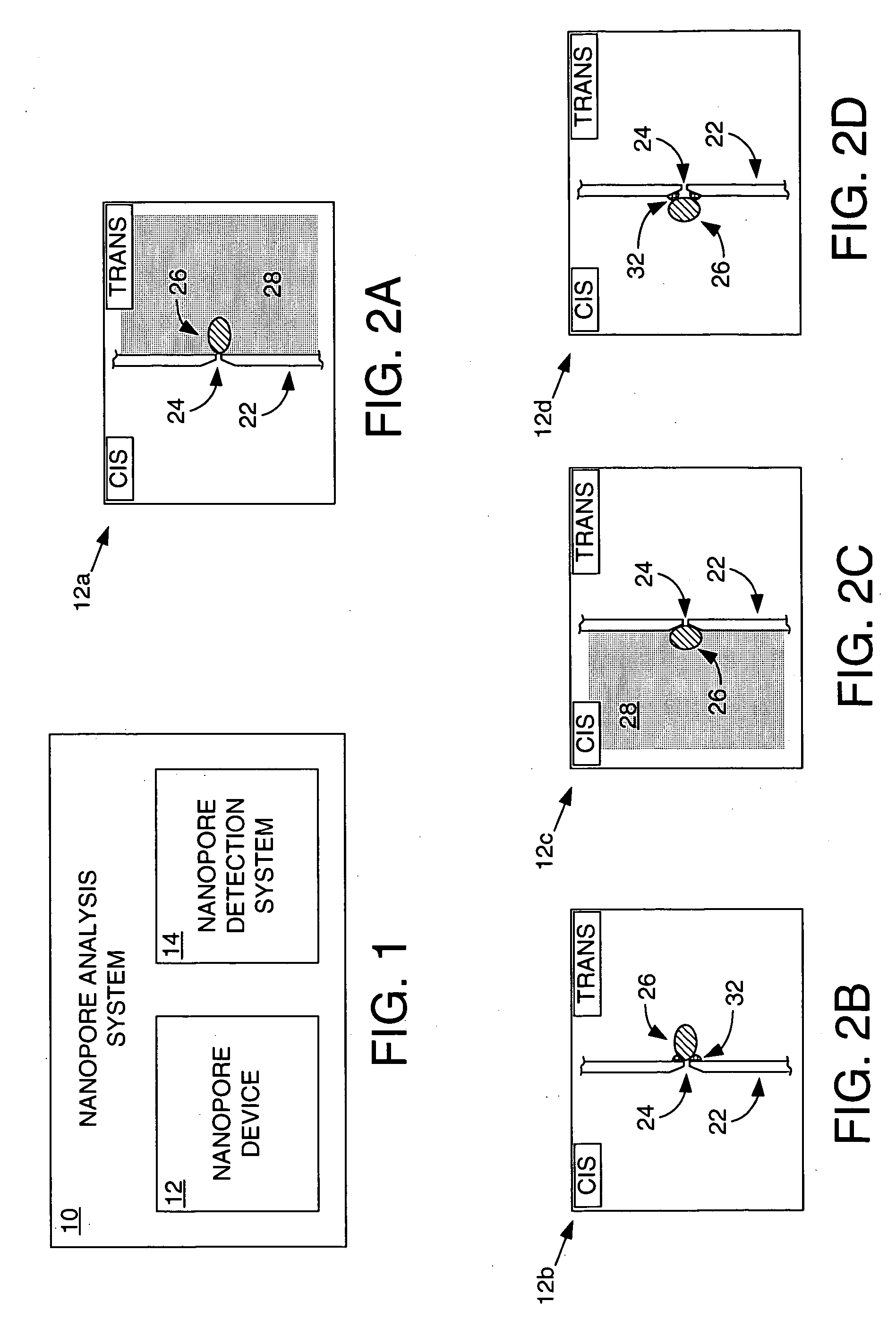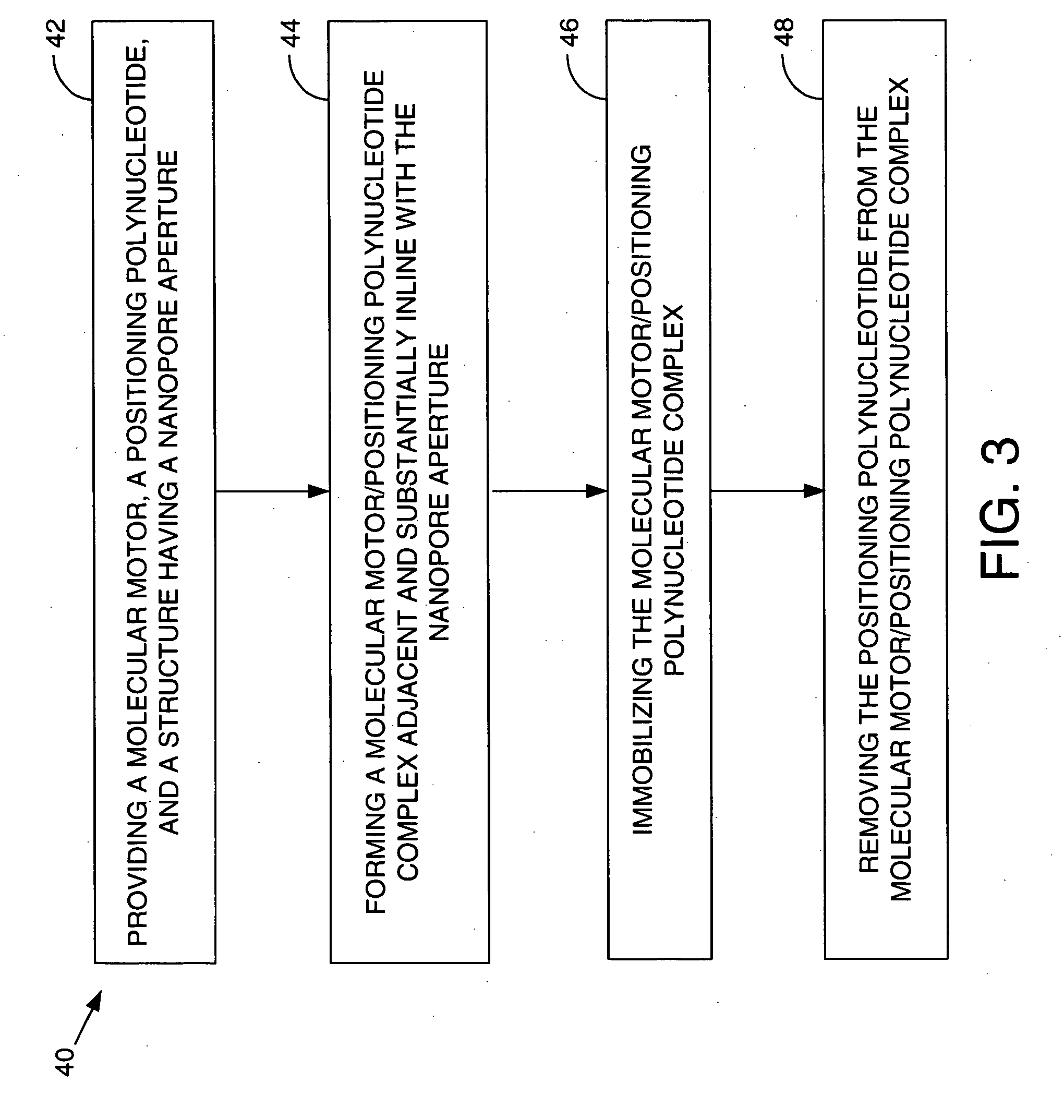Methods and apparatus for characterizing polynucleotides
a polynucleotide and polynucleotide technology, applied in the field of methods and apparatus for characterizing polynucleotides, can solve the problems of difficult correlation between the length of any given polynucleotide and the translocation time, and the control of the rate at which the target polynucleotide is analyzed by the nanopore analysis technique, so as to reduce the probability of backward movement
- Summary
- Abstract
- Description
- Claims
- Application Information
AI Technical Summary
Benefits of technology
Problems solved by technology
Method used
Image
Examples
example 1
E. coli Exonuclease I
[0092]E. coli Exonuclease I catalyses digestion of single stranded DNA from 3′ termini, releasing 5′-phosphorylated mononucleotides and leaving 10 nt or shorter fragments at completion. It functions as a monomer, forming a ring that binds to a 13 base sequence at the 3′ ssDNA terminus (Brody Biochemistry 30:7072 (1991)). Binding is relatively weak (Km˜1 μM) (Brody et al. J. Biol. Chem. 261:7136 (1986)), and ssDNA hydrolysis is inhibited by 3′ phosphorylation. Processivity has been estimated to be >900 nt in bulk studies (Brody et al. J. Biol. Chem. 261:7136 (1986)). FIG. 11 shows DNA being moved through a nanopore by Exol.
[0093]FIG. 12 shows a nanopore experiment in which we examined a synthetic ssDNA 64mer (1 μM final concentration) before and after addition of 1 μM Exonuclease I (Solbrig et al. “DNA processing by lambda-exonuclease observed in real time using a single-ion channel.” Biophysical Society, February, Baltimore, Md. (2004)). In the absence of the ...
example 2
λ Exonuclease
[0094]λ exonuclease is a 24 kD protein encoded by phage λ. This enzyme strongly binds duplex DNA at 5′ phosphorylated blunt- or 5′-recessed ends (Km˜1 nM) (Mitsis et al. Nucl. Acid Res. 27:3057 (1999)), and digests one of the strands in the 5′ to 3′ orientation. Analysis of X-ray crystals (Kovall et al. Science 277:1824 (1997); Kovall et al. Proc. Natl. Acad. Sci. U.S.A. 95:7893 (1998)) revealed that the functional enzyme is a homotrimer which forms a toroidal structure with a hole in its center that tapers from 3.0 nm at one end to 1.5 nm at the other (FIG. 13). It is inferred that dsDNA enters the trimer complex through the 3 nm opening and that the intact single strand exits the opposite side via the 1.5 nm aperture. Recent single molecule studies indicate that the enzyme cuts at tens of nt s−1 at room temperature (Perkins et al. Science 301:1914 (2003); van Oijen et al. Science 301:1235 (2003)). In vitro digestion of single dsDNA molecules is characterized by nearl...
PUM
| Property | Measurement | Unit |
|---|---|---|
| diameter | aaaaa | aaaaa |
| pH | aaaaa | aaaaa |
| diameter | aaaaa | aaaaa |
Abstract
Description
Claims
Application Information
 Login to View More
Login to View More - R&D
- Intellectual Property
- Life Sciences
- Materials
- Tech Scout
- Unparalleled Data Quality
- Higher Quality Content
- 60% Fewer Hallucinations
Browse by: Latest US Patents, China's latest patents, Technical Efficacy Thesaurus, Application Domain, Technology Topic, Popular Technical Reports.
© 2025 PatSnap. All rights reserved.Legal|Privacy policy|Modern Slavery Act Transparency Statement|Sitemap|About US| Contact US: help@patsnap.com



